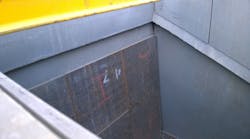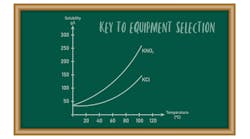Bulking Up: Wear-Resistant Materials for Powder, Solids Handling Equipment
The harsh environment of chemical processing facilities can place a considerable stress on equipment. Wear and degradation are major issues in applications, such as bulk material handling equipment and slurry-handling machinery. The threat to operations is significant when you consider the cost of repairing equipment, replacing parts or machine failures. Production interruptions and unscheduled shutdowns add to the mounting challenges faced by the industry. Many wear-resistant materials, including abrasion-resistant alloys and wear-resistant overlays, can help chemical processing operations minimize disruptions while maximizing productivity.
Defining Wear
Parts wear involves a gradual decay or erosion of the components. When a part and component become so eroded and degraded that it cannot perform adequately, it should be replaced or rebuilt. The causes of wear are different. Understanding the wear factors involved is essential before choosing a wear-protection material for an application. The selection of wear-resistant material depends on the types of wear involved. The overall wear experienced in an application is usually a combination of two or more types of wear and degradation, complicating the selection of wear-protection materials.
Abrasive wear
Materials rubbing against a part or component cause abrasive wear. Abrasive wear accounts for about 50% of all wear on metallic components. It includes three sub-categories:
- Low-stress scratching abrasion
- High-stress grinding abrasion
- Gouging abrasion
Low-stress scratching abrasion is typically the least-severe type of abrasion. Metal parts wear through the repeated scouring action of hard, sharp particles moving across a metal surface at varying velocities. The velocity, hardness, edge sharpness, angle of introduction and size of the abrasive particles all combine to affect the amount of abrasion caused. Alloys containing carbide (particularly chrome-carbide) are an option for preventing low-stress abrasive wear. Due to the absence of impact, the relatively brittle high carbon-chromium steel alloys are well suited for low-stress abrasive applications. Typical components subject to low-stress scratching abrasion include chutes, screens and slurry-pump nozzles.
High-stress grinding abrasion is more intense than simple scratching. It happens when small, hard, abrasive particles push against a metal surface with enough force to crush the particle in a grinding mode. Sometimes the compressive pressure occurs when two metal components have an abrasive sandwiched between them. Often this is referred to as three-body abrasion. In this situation, the surface becomes scored and surface cracking can occur. There are examples of softer, tough alloys outperforming harder alloys in grinding abrasion applications.
The successful range of alloys includes austenitic manganese, martensitic irons and some carbide-containing alloys (usually smaller carbides like titanium carbide) in a tough matrix. Typical components subject to high-stress grinding abrasion include augers, scraper blades, pulverizers, ball-and-rod mills, roll crushers, rollers, sprockets and mixing paddles.
Gouging abrasion is another type of abrasive wear. High-stress or low-stress abrasion wear can be extreme when accompanied by some degree of impact and weight. The surface parts and components receive prominent gouges and grooves when massive objects, such as large lumps of bulk materials, press against them. In all different applications with low, medium and high-speed impacts, the action of the material on metal might be like that of a cutting tool. Gouging abrasion also places a premium on toughness. Sometimes this calls for harder, more abrasion-resistant alloys, such as carbide-containing alloys supported by a tougher alloy. Typical components subject to gouging abrasion include gyratory crushers, roll crushers and jaw crushers.
High-impact wear
When the stress on a metal component exceeds the elastic limits of the metal, it deforms beneath the point of impact and laterally across the surface away from the impact point. Very brittle materials (such as ceramics) can’t withstand deformation; therefore, they may crack from either severe or repeated lighter blows. Even if the metal is ductile enough to avoid cracking, the repeated impact often compresses the surface, sometimes causing the metal to mushroom at the edges and eventually chip off. Typical components subject to impact wear include transfer chutes and hoppers.
Corrosive wear
Metals can be subject to many forms of corrosion, and each one can cause wear damage. The most common type of corrosion is rust. The rust transforms the surface of a metal into an oxide that eventually flakes off, reducing the original thickness of the metal. Too often, corrosion related to surfacing is a secondary wear factor in bulk material and slurry applications. Although many hard-surfacing alloys offer a certain amount of protection against corrosion, selecting a surfacing alloy should be handled as a separate issue for a specific corrosive application.
Adhesive wear
Adhesive wear accounts for about 15% to 20% of all wear, often caused by non-lubricated friction of metal parts (such as bearings in machinery). Regardless of their finish, metal surfaces contain microscopic high and low areas. As metal surfaces slide against each other, the high areas break, and tiny fragments of metal tear away. The continual removal of metal roughens the working surface and contributes to more wear. Martensitic hard-surfacing alloys are a good choice to resist metal-to-metal wear. Other alloys used successfully include austenitic manganese and cobalt-based alloys.
Wear Types vs. Material Selection
When selecting wear protection, chemical processing operators should first focus on the primary factors leading to degradation and then consider any secondary causes. For example, if the primary wear factor is abrasion, and the secondary wear factor is light impact, choose a wear-protection alloy with high-abrasion resistance and a fair amount of impact resistance.
Steel alloys
Steel or iron-based hard-surfacing alloys account for the most significant usage of the hard-surfacing alloys and can be subdivided according to their metallurgical phase or microstructure. Each type of steel alloy (iron-based alloy) resists certain forms of wear better. Also, there are commercial considerations, such as cost and availability, and other factors, including mechanical properties and corrosion resistance. Selecting the proper steel alloy for each application requires careful consideration. There have been many types and subgroups of steel alloys. In simple terms, the primary steel alloys fall into three subgroups: austenitic, martensitic and carbide, though there could be other types or subgroups as well.
Austenitic alloys
Austenitic alloys provide stable austenite – even on carbon in high-dilution situations and low-alloy steels. Well-designed austenitic surfacing alloys are extremely tough, ductile and work-hardenable. They offer excellent impact resistance but low-abrasion resistance (with some improvement as they work-harden). As an indication, these alloys will normally work-harden to a nominal surface hardness up to 50 HRC (Rockwell scale). Although this improves the abrasion resistance of these alloys, they still retain their good impact resistance.
Martensitic alloys
Martensite is a hard, micro-structural phase formed in steels by rapid cooling. Since martensitic alloys are air-hardenable, the cooling rate is important in the final hardness. Faster cooling usually results in harder surfacing deposits. Preheating between 120°C and 320°C is generally required when working/welding martensitic alloys. This is to avoid cracking in the alloy deposit.
With relatively low carbon and alloy, martensitic alloys are also used for build-up on carbon and low-alloy steels. Their relatively high compressive strength, toughness and good material-to-metal sliding provide solid wear resistance. Martensitic alloys with a higher carbon and higher alloy content exhibit significantly higher deposited hardness. This hardness gives them better abrasive/wear resistance.
Martensitic hard-surfacing alloys provide a desirable balance of impact and abrasion resistance. An optimum combination of abrasion, adhesion and impact resistance is possible when choosing the proper carbon-chromium content. Martensitic alloys can respond to heat treatment, making it possible to change their hardness and toughness.
Carbide alloys
Carbide alloys form when alloying a percentage of carbon with a minimum amount of alloy (primarily chromium). The process results in the formation of hard carbides, which are disperse throughout the surfacing deposit. These dispersed carbides are much harder than the surrounding matrix and provide excellent abrasion resistance.
When using lower amounts of carbon, the quantity of carbides formed in the matrix is small. The resulting alloy exhibits exceptional abrasive/wear resistance while retaining toughness. These carbide-surfacing alloys resist a combination of abrasion and impact. As the carbon content increases in the carbide-containing alloys, the quantity of carbides produced increases. The higher percentage of carbides increases the abrasion resistance while the toughness decreases. As carbides are undermined and knocked out by moving abrasive particles, additional carbides surface to resist abrasives further and delay wear.
Overlays and clads
Many different types and materials of wear-resistant overlays (or clads) are available in market. These overlays or clads have been extra-hard layers, which give a very high wear/abrasive resistance in high/moderate-stress applications with moderate- to low-impact conditions. In other words, there is a hard-faced (overlay) to parent/base steel components. One example of such overlay material is chromium carbide.
An overlay is usually an exotic material whereas the parent/base material (such as the body of the equipment) is a cost-effective steel with desired mechanical properties. But the overlay or cladding process can be complex. Overlays and clads are more susceptible to damage during the formation process, and they tend to have short lifespans. It’s important to follow detailed procedures and pay particular attention to quality control to ensure reliability, long life and high performance. This process is typically cost effective when performed properly and on a large scale. However, for small manufacturers and small-scale works, such as a repair or maintenance shop within a chemical plant, overlays and clads may be too costly. As a rough indication, the hardness achieved for such a hard-faced overlay is in 55-62 HRC range (approximately HB560-680).
As another rough indication, the wear-resisting performance of such a hard overlay is 12 to 20 times more than ordinary steel. For large-scale equipment/facilities, such a wear-resistant overlay might be used in 8-mm to 25-mm cladding for an effective application. For small-scale equipment and units, smaller thicknesses might be appropriate. There could be different combinations for base material, layers, layer configuration, thicknesses and others.
Through-hardened wear-resistant alloy steels
There have been different types and tradenames of through-hardened wear-resistant alloy steels. They typically offer the optimum combination of hardness and impact resistance and formability for many wear applications. They have been simple to use, and they can be effectively employed in small-scale manufacturing/maintenance works by small companies in small/medium-scale manufacturing/refabrication of equipment and machinery.
Ceramics for wear resistance
Ceramics combine extreme hardness with high strength to provide excellent wear resistance. They successfully resist various solid, liquid and slurry abrasive, corrosion, high-temperature, thermal shock and many other forms of abuse. Alumina, silicon carbide and silicon nitride are just some examples.
The details of how to use ceramics properly, such as how to install ceramic liners on internal/intended equipment surfaces, how to bond them to the equipment, and how the overall assembly behaves in the operation are critical. There have been limitations, challenges and difficulties with many ceramics. Ceramics are brittle and fracture with little or no plastic flow. Unlike metals, gross fracture can occur when exceeding the elastic limit. It’s important to avoid placing ceramics under tensile stresses and high-impact levels. Facture, cracking and failures are common risks in such scenarios. Also, compare how ceramics have been applied to similar industrial uses. Overall, ceramics often perform and operate different from metals, requiring careful attention in their applications.
Ceramic wear liners are highly durable anti-wear solutions if applied carefully and correctly. There have been different methods for their installation. Each application has unique requirements and challenges. Too often, ceramic liners should be custom-cut for the intended equipment. On the other hand, standard patterns or a kind of standardization can be applied for many applications. This includes several types of traditional tiles to cover different equipment, such as varying shapes and sizes of chutes. The cold vulcanization of ceramic tiles is common in many applications. However, there have been other methods for installing ceramic liners. For instance, ceramic tiles might be embedded within a flexible and impact-resistant rubber delivers the highest level of resistance to sliding abrasion and particle impact. For instance, vulcanized steel backing for mechanical fastening has been successfully used in certain applications.
Selection Tips for Wear-Resistant Materials
There is no general rule for selecting wear-resistant materials. The overlay option, cladding and different grades of alloys and ceramics are suitable for different wear-resistant parts. Ceramic’s exceptional properties, such as extreme hardness, mechanical strength, corrosion resistance and others, make it an option for some wear-resistance applications.
For small-scale works, through-hardened wear-resistant alloy steels may be simpler, cheaper and better, depending on the grade of steel. But convincing a technical team to switch to new materials isn’t always easy. The operator may have a preferred option and insist on using it if the new material offers only theoretical or marginal benefits.
The long-term operational history in each specific application can provide a good guide for the selection of wear-resistant materials.




